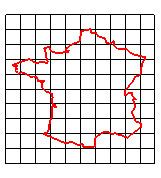A geometric transformation is any bijection of a set having some geometric structure to itself or another such set. Specifically, "A geometric transformation is a function whose domain and range are sets of points. Most often the domain and range of a geometric transformation are both R2 or both R3. Often geometric transformations are required to be 1-1 functions, so that they have inverses." The study of geometry may be approached via the study of these transformations.
Geometric transformations can be classified by the dimension of their operand sets (thus distinguishing between planar transformations and those of space, for example). They can also be classified according to the properties they preserve:
displacements preserve distances and oriented angles;isometries preserve angles and distances;similarities preserve angles and ratios between distances;affine transformations preserve parallelism;projective transformations preserve collinearity;Each of these classes contains the previous one.
Circle inversion preserve the set of all lines and circles in the planar case (but may interchange lines and circles), and Möbius transformations conserve all planes and spheres in dimension 3.Diffeomorphisms (bidifferentiable transformations) are the transformations that are affine in the first order; they contain the preceding ones as special cases, and can be further refined.Conformal transformations, preserving angles, are, in the first order, similarities.equiareal transformations, preserve areas in the planar case or volumes in the three dimensional case. and are, in the first order, affine transformations of determinant 1.Homeomorphisms (bicontinuous transformations), preserve the neighborhoods of points.Transformations of the same type form groups that may be sub-groups of other transformation groups.

